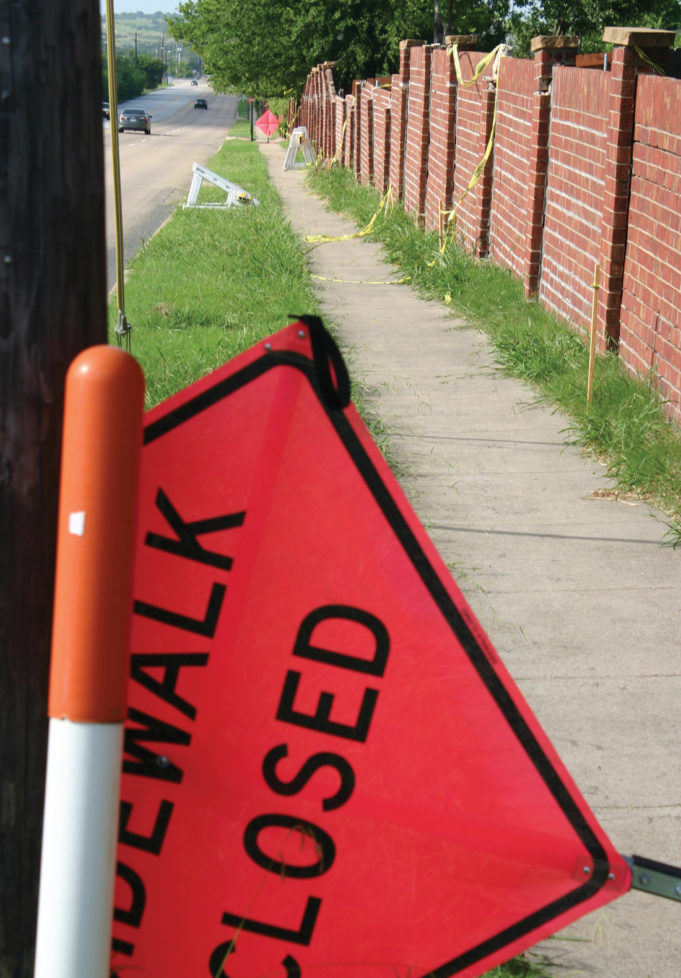The brick wall along Chapel Creek Boulevard in far West Fort Worth is getting worse.
This 6-foot-high, 2,000-foot-long privacy barrier between the boulevard and the neighborhood of Little Chapel Creek started falling apart not long after it was built in 1998. Now it’s a holy mess. The wall leans in places and has begun to crumble along sloping areas. Some bricks have spilled out onto the sidewalk.
Last October, Fort Worth Code Compliance workers told 15 homeowners along the boulevard that the wall had become a safety hazard and needed to be fixed or replaced. A fine of up to $2,000 a day could be imposed as long as the wall remained in violation (“A Large Bill,” April 20, 2016).
A few homeowners sought estimates and discovered it would cost thousands of dollars per homeowner to replace their sections. Code Compliance sent out another round of letters in February giving the homeowners until February 29 to take action on the wall. The residents howled. The city postponed the deadline.
On April 4, Code Compliance sent letters giving the residents 180 days to come up with a plan to replace or repair the wall.
Neighborhood leaders have struggled to wrangle all of the homeowners into one place to discuss a plan. A meeting was scheduled two weeks ago, and only a handful of people showed up, said Jim Stachan, whose backyard includes about 125 feet of the wall.
“I don’t know why the residents aren’t taking this seriously,” Strachan said.
A handful of the properties are rental units, and the occupants have no financial responsibility for the wall –– their landlords do. The city has threatened to replace the wall and pass the bill along to the homeowners in the form of liens. However, liens don’t have to be paid off until the property is sold, meaning the debt can be delayed or passed along to the next buyer.
City officials expect the wall to cost more than $100,000 to tear down and rebuild. Financial responsibility for replacing the wall is falling solely on the homeowners.
But residents say the city officials bear some if not all of the liability.
“It’s wrong to act like this wall is our fault,” Strachan said. “I’m not taking this lying down. That wall is not going to be the end of me financially.”
Strachan, a disabled veteran living on a fixed income, has spent the last three years living in this pleasant looking middle-class neighborhood where houses sell for around $150,000. Nobody disputes that the wall was built by a developer on private property that was later divided into various lots for houses. Once the houses were built and sold, the homeowners agreed to bear the responsibility for their section of wall. But Strachan and others blame city employees for allowing the wall to be built in such a careless manner.
Gary Hogan, president of the Chapel Creek Neighborhood Association, researched the history of the wall several years ago and discovered the developer, whose name he has forgotten, had retired and moved to Florida. Hogan tracked down the contractor who built the wall, Steve Jennings, of Hurst.
“He told me, ‘Mr. Hogan, when I build a wall for a developer, I ask them what they want: a 10-year wall, a 20-year wall, or the Great Wall of China.’ ”
Little Chapel Creek’s developer ordered the cheapest wall with a 10-year warranty, Hogan said. The warranty expired in 2008.
At first, Jennings agreed to attend a neighborhood meeting, look at the wall, and come up with ideas to fix it. But he canceled his visit after a homeowner threatened to sue him for building such a shoddy wall, Hogan said.
Hogan believes that Jennings had worked without the proper permits, although the neighborhood association president offered no supporting evidence. Based on his research, he came to the conclusion that a resident became concerned during the wall’s construction, saying the contractor appeared to be taking shortcuts, such as using mud instead of concrete. The resident began videotaping the workers, who promptly called the cops. The resident complained to police about the crew’s quality of work. Police called a city inspector, Hogan said, who issued a cease and desist order.
Work resumed once Jennings acquired a permit, Hogan said. Residents say the city should have made him tear down what he had built and start over.
“Back in the 1990s,” Hogan said, “the city of Fort Worth was not real great at inspecting stuff they should have been paying attention to.”
City officials, concerned for public safety, have closed off the sidewalk next to the wall. City workers put up barriers and yellow police tape recently to keep pedestrians off the sidewalk for fear that the bricks would continue collapsing and hurt someone. City officials asked homeowners to come up with a replacement plan by this fall, but residents have shown little motivation. Strachan said none of them has thousands of extra dollars lying around.
Similar brick barriers can be seen in other subdivisions around town, but none of the walls appears to be crumbling so quickly and severely. City councilmember Zim Zimmerman, whose district includes Little Chapel Creek, can’t recall the demolition of any other walls for safety reasons.
The city is limited in its response, Zimmerman told the Weekly in April, since it cannot spend taxpayer money repairing a private structure on private property.
“I’m pretty sure now that anything a developer puts up is going to be inspected,” Zimmerman said. “Obviously, the [Little Chapel Creek] developer is long gone, and even if he was around he would deny anything was done wrong. The statute of limitations is probably way gone by now.”
Hogan suspects that city officials are taking a hard stance against providing any financial help to property owners.
“If we were the only wall they had to deal with like this, we might get some help with demolition and public works,” Hogan said. “But what they are really fearful of is that there are more walls in this predicament, and they don’t want to set a precedent.”
The homeowners say the city should pay for part or all of the costs to replace the wall. Some residents bought their properties long after the wall was built. Strachan, for instance, bought his house in 2013. The person who sold Strachan the house did not tell the new owner that the fence was his financial responsibility. Other homeowners tell similar tales, Hogan said.
“The hardest part to swallow is the demolition cost of this wall,” Hogan said. “That is the most expensive part of it, tearing down this dilapidated wall.”
Several contractors have made bids. One contractor wanted $170,000 to tear down, remove, and rebuild the wall. At that rate, the 15 homeowners could be expected to pay an average of more than $10,000 each.
“People were not prepared for this,” Hogan said. “You are talking about second or third property owners who never understood that was their fence.”













Lonnie J Strachan bought his place in 2013. You can confirm that at tad.org (Tarrant Appraisal District). With the purchase year, you can go to TarrantCounty.com and do a 2013 property records search for Lonnie Strachan. It shows he bought his place on a VA loan, and you can read the deed of trust. (With the street address, you can go to Google Maps, satellite view, and see the brick wall).
The wall was already in serious disrepair in 2013, and I seriously doubt that there was NO professional inspection before Strachan purchased. And he cannot imply that his seller knew it was the homeowner’s responsibility to repair the fence, but concealed it from Strachan, while simultaneously arguing that NOBODY knew it was the homeowner’s responsibility.
Whether a person buys real property with no inspection, or is intentionally deceived by a seller’s statements, it’s still the buyer’s problem. Fort Worth taxpayers cannot and should not be liable for every property owner who makes a bad purchase. And whether the purchaser is a disabled vet on a fixed income, or a sweet little old widow with ten kids, is totally irrelevant.
Jim Strachan said he bought his house in 2013, which I also verified through TAD records.
Inspections and estimates to replace the damaged wall were performed in 2008. I mixed up those dates in the story (now corrected). That was my error not Strachan’s.
So has he lived there for eight years, or three? I think you need another correction.
John Boy Wilton at least gets one thing right, he has some serious doubts, but folks who know him have no doubts whether or not he’s a Tea-Bagging knuckle-head, God bless him. He is the most recent flake to volunteer his half-witted service to our local, hammer-headed, Tea-Bagging Group to harass the Weekly Blog. Aren’t Baggers special? God bless America! I don’t really know if his mama had any brats that lived or not. Does anyone know for sure?
Pointing out an error in a story doesn’t make John Boy Wilton a hammerhead or a tea-bagging knucklehead. Feel free to state your opinions but please refrain from personal attacks, Benny.
Please forgive me Jeff, I would not suggest for an instant that the jerk would be acting as a big shot government honcho were it not true. My Priest is thinking no, but he is only a man not a kid.Yes,some fools disagree that if a sweet little disabled widow with kids is sold a house, then was intentionally deceived on the deal, that this vile outrage is totally irrelevant. What the hell? My bird-dog has a much kinder heart than that, but she Isn’t a government lawyer who is sky-larking on the tax-payers dime. How smart do you need to be to figure this out? Fools are fools, piss-ants are piss-ants.The piss-ant now sends mail to me on the countys time. He’s a piss-ant & nuckle-head. Nothing to see here, and so it goes. A tea-bagging snot-rag behaves like a fifth-grade piss-ant..there you have it. It’s not my fault. I got him on my payer list. You care to read or see the childish crap he is mailing to my home? Forget that dirtballs whining.It’s no one’s problem but his own. I’m certain he will be up In Washington D.C. with his Daddy Mr.Trump. Pray for Peace. Benny
You need to pray for sanity Benji.
Hey Jeff, thanks for writing this story. I live near Chapel Creek and drive it almost everyday.
This is an idea i’ve had for while…What about setting up a TIF district to help pay for the repairs? Simply make the district the homes that are along the stretch of the wall and have those local property tax dollars pay for the repairs. The baseline property taxes will still go to the city to keep funding basic city services however the increases in taxable property value will go to this TIF district to pay for the wall. That way, the home owners are happy because they aren’t footing the bill directly out of pocket and the city is happy because you don’t have the rest of Fort Worth subsidizing this piece of private property. Isn’t this what a TIF district was originally meant for? To help fight blight? (I’m not saying this area is blighted but if repairs aren’t done it does contribute) And allow local property tax dollars to go to work in improving the area in which they are located?
TIFs were created in Texas to “assist in financing development of unimproved or blighted land by dedicating the real estate property taxes to be generated by the built project to a TIF Fund for payment of the principal and interest on TIF Bonds.”
That’s kind of vague and open to interpretation. Fort Worth uses TIFs to promote development — Stockyards, Downtown, Near South, Cabelas, medical district, Lancaster, and so on. Creating a TIF to pay for the Chapel Creek wall doesn’t seem to come close to qualifying based on city officials’ use of TIFs. Also, a TIF would probably include your entire neighborhood, meaning everyone’s taxes would be paying for the wall that is on only 15 properties. That might get tricky. Your idea sounds intersting, but one to pitch to Gary Hogan or Zim Zimmerman.
From my reading of the state statue, the language seems to allow for a use such as this. See – Sec. 311.005. CRITERIA FOR REINVESTMENT ZONE. Even though the city historically hasn’t used TIF districts in this manner. I’ll reach out.
Those were brick fences. The contractor, Steve Jennings, needs to be run out of Texas on a rail. A brick fence should be made to last near forever. That he claims he can sell one that has a 10 year warranty is a joke. You can tell that too much sand and not enough concrete was used in the mortar. That mortar started eroding almost immediately. If the guy had any pride or character, he’d only build one kind of brick fence….one built to last.
Hogan settle down little buddy….